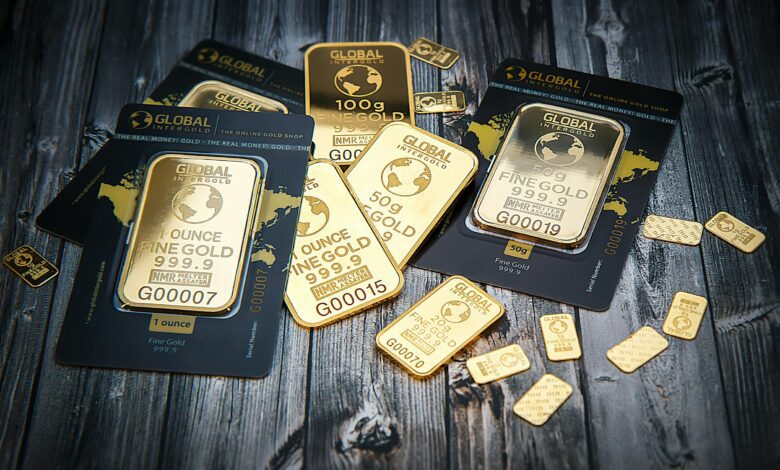Gold in a Global Crisis: How Geopolitical Tensions Drive Demand and Prices

In an unpredictable world marked by geopolitical tensions, the allure of gold remains steadfast as a symbol of stability and security. Historically revered as a safe-haven asset, gold has a unique relationship with global conflicts and political unrest, often witnessing a surge in demand during uncertain times. As nations grapple with shifting alliances, trade disputes, and military confrontations, the dynamics of the gold market become increasingly complex and fascinating. This article delves into the multifaceted ways geopolitical tensions influence gold demand and prices, exploring its timeless appeal as a refuge for investors in volatile environments. We will first examine the intrinsic qualities that make gold a go-to asset during crises, before analyzing real-time market reactions to political strife and offering strategic insights for navigating investment opportunities in the midst of global turmoil. Join us as we uncover the intricate interplay between geopolitics and gold, shedding light on how these forces shape the financial landscape.
- 1. "The Safe Haven Appeal: Understanding Gold's Role Amid Geopolitical Uncertainty"
- 2. "Market Reactions: How Political Strife Shapes Gold Prices in Real-Time"
- 3. "Investing in Turmoil: Strategies for Navigating Gold Demand During Global Conflicts"
1. "The Safe Haven Appeal: Understanding Gold's Role Amid Geopolitical Uncertainty"
In times of geopolitical uncertainty, gold consistently emerges as a preferred asset for investors seeking stability. This phenomenon can be attributed to gold's long-standing reputation as a "safe haven" investment, which is particularly pronounced during periods of heightened tensions, such as military conflicts, political unrest, or economic crises. When traditional markets exhibit volatility or when fears about currency depreciation arise, investors often flock to gold as a safeguard for their wealth.
The intrinsic value of gold, derived from its scarcity and durability, bolsters its position as a reliable store of value. Unlike fiat currencies, which can be affected by inflation and government policies, gold maintains its purchasing power over time. This characteristic becomes especially appealing when geopolitical events threaten the stability of financial systems or the global economy. For instance, during conflicts, such as the Ukraine crisis or tensions in the Middle East, gold prices typically rise as investors seek to mitigate potential losses in other asset classes.
Moreover, gold's liquidity adds to its allure. Investors can easily buy or sell gold in various forms—be it physical bullion, coins, or financial instruments like ETFs—making it an accessible option for those looking to hedge against uncertainty. Additionally, central banks often increase their gold reserves during turbulent times, further driving demand and reinforcing the metal's status as a safe haven.
The psychological aspect of investing in gold cannot be overlooked; it serves as a tangible asset that provides a sense of security. In a world marked by unpredictability, the assurance of holding a physical commodity can be more comforting than digital assets or stocks. As geopolitical tensions escalate, the combination of heightened demand, speculative trading, and strategic reserve accumulation tends to push gold prices upward, creating a feedback loop that reinforces its appeal as a safe haven. Thus, understanding gold's role amid geopolitical uncertainty is crucial for investors looking to navigate the complexities of the global market landscape.
2. "Market Reactions: How Political Strife Shapes Gold Prices in Real-Time"
Geopolitical tensions have a profound and immediate impact on gold prices, often leading to noticeable market reactions. When political strife emerges—whether through military conflict, sanctions, or diplomatic disputes—investors typically flock to gold as a safe haven asset. This behavior is rooted in gold’s historical reputation as a store of value and a hedge against economic instability.
In times of uncertainty, such as during a military confrontation or economic sanctions against a nation, market participants react swiftly. News headlines detailing escalating tensions can trigger a spike in gold prices as demand surges. For instance, during the Russia-Ukraine conflict, gold prices experienced significant increases as investors sought refuge from the volatility in stock markets and the potential decline in other asset classes. The immediate response is often reflected in real-time trading, where gold futures and spot prices react sharply to breaking news.
Moreover, the interplay between geopolitical events and market sentiment cannot be overstated. Investor psychology plays a crucial role in shaping gold demand during crises. As fears of economic downturns or financial instability rise, the perception of risk intensifies, further driving up gold prices. This phenomenon is particularly evident in situations where currency values fluctuate dramatically in response to geopolitical events. When a currency weakens—often a consequence of political strife—gold becomes more attractive, leading to increased purchases by both individual and institutional investors.
Additionally, the role of central banks in these scenarios cannot be overlooked. In times of geopolitical turmoil, central banks may increase their gold reserves as a precautionary measure against potential economic fallout. This accumulation can further elevate gold prices, reflecting both protective strategies from financial institutions and broader market reactions to geopolitical realities.
In summary, the real-time impact of political strife on gold prices is characterized by a swift market response driven by investor behavior, economic ramifications, and central bank policies. As global tensions rise, gold remains a critical barometer of market sentiment, illustrating its enduring status as a safe haven asset amid uncertainty.
3. "Investing in Turmoil: Strategies for Navigating Gold Demand During Global Conflicts"
In times of global conflict and geopolitical turmoil, the demand for gold often surges as investors seek safe-haven assets to protect their wealth. The historical precedent indicates that during crises—be it military conflicts, economic sanctions, or political upheavals—gold tends to maintain or even increase its value as it is perceived as a stable store of value. Investors looking to navigate the complexities of gold demand during such tumultuous periods can employ several strategies to optimize their investments.
First, diversification remains a cornerstone of effective investment strategy. By allocating a portion of their portfolios to gold, investors can mitigate risks associated with other asset classes that may be more vulnerable to geopolitical shocks. This could include a mix of physical gold, gold ETFs, or gold mining stocks, each offering different levels of exposure and risk. While physical gold provides tangible security, ETFs offer liquidity and ease of trading, while mining stocks can benefit from rising gold prices but introduce operational risks associated with the mining industry.
Second, staying informed about geopolitical developments is crucial. Investors should keep abreast of international news, government policies, and economic indicators that signal potential conflict or instability. Understanding the context surrounding geopolitical tensions allows investors to make timely decisions about entering or exiting gold positions. For instance, an escalation in a region's conflict might prompt immediate action to increase gold holdings, while signs of de-escalation could indicate a shift toward riskier assets.
Lastly, employing a tactical approach to timing can enhance investment outcomes. This involves monitoring price movements and market sentiment closely. During periods of escalating tensions, gold prices may spike, creating opportunities for short-term trading strategies. Conversely, if a conflict appears to stabilize, investors might consider taking profits or rebalancing their portfolios to capitalize on potential dips in gold prices. Utilizing technical analysis can also help identify support and resistance levels, guiding decisions on when to buy or sell.
In summary, while global conflicts can create uncertainty and volatility in the financial markets, strategic investing in gold can provide a hedge against such risks. By diversifying their portfolios, staying informed about geopolitical events, and employing tactical timing strategies, investors can effectively navigate the complexities of gold demand during periods of turmoil. Ultimately, a well-considered investment strategy can provide not only protection during crises but also opportunities for growth as global dynamics shift.
In conclusion, the intricate relationship between geopolitical tensions and gold demand underscores the metal's enduring status as a safe haven in times of uncertainty. As explored in this article, the allure of gold becomes particularly pronounced during periods of political strife, when investors seek refuge from market volatility and economic instability. The immediate market reactions to global events reveal how swiftly gold prices can fluctuate in response to crises, highlighting its role as both a barometer of geopolitical risk and a strategic asset for investors.
Furthermore, navigating gold investment during tumultuous times requires a nuanced understanding of the underlying dynamics at play. By adopting well-informed strategies, investors can capitalize on gold's unique characteristics while mitigating risks associated with geopolitical upheaval. Ultimately, as the world faces an increasingly complex geopolitical landscape, gold will likely continue to be a critical component of investment portfolios, serving as a reliable safeguard against the uncertainties of our times. As we look ahead, the interplay between global conflicts and gold demand will remain a vital area for investors to monitor, ensuring that they are well-prepared to respond to the challenges and opportunities that lie ahead.





